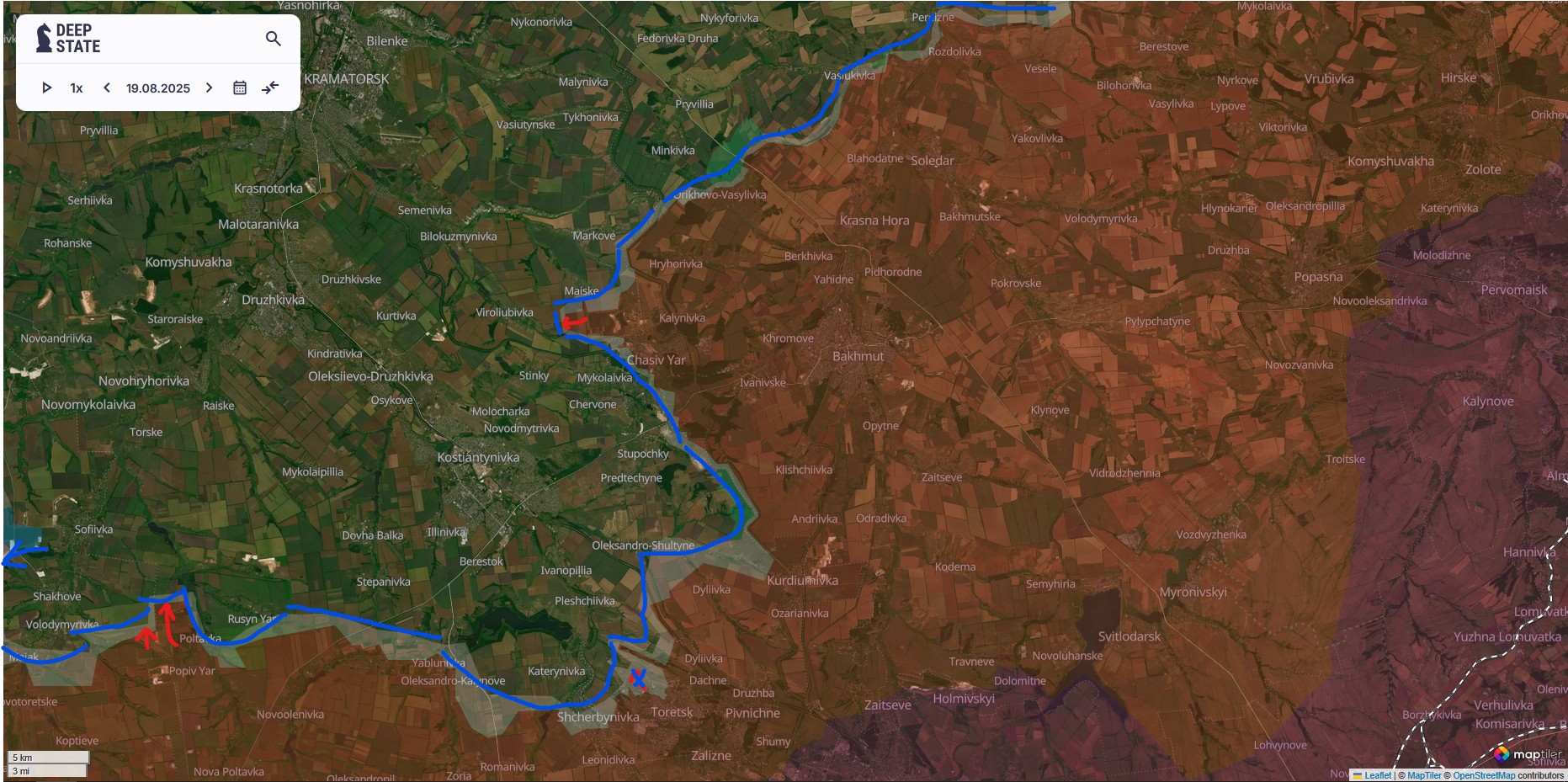Ukraine's 2025 Counteroffensive: Initial Foreshocks
The Pokrovsk and Sumy counterattacks may only be the tip of the iceberg; once back from diplomatic duties abroad, Zelensky looks likely to let a substantial counteroffensive proceed.
Media coverage of the Ukraine War continues to stand in stark contrast with the material evidence on the ground. It’s an ongoing insult to all to those still shedding their blood, as well as the memory of the tens of thousands who have perished in defense of Ukraine, how the story of their fight gets so distorted by journalists and politicians abroad.
On the plus side, this silly media milieu also functions as a highly effective smokescreen, a maskirovka in the true Soviet usage, helping cloak Ukraine’s true capabilities and plans. If you apply a consistent, energy-based logic to evaluating Ukraine’s fight since 2022, then the trope of exhausted Ukrainian fighters barely clinging to ground can only be seen as deliberately manufactured for a purpose.
Ukraine’s leadership appears to be exploiting this mistaken narrative to prepare another surprise for Putin. Hopefully this will be the shock that finally does him in. But hey, maybe I’m wrong and nothing will happen at all.
Still, important signs continue to appear suggesting that something big is afoot. The signals are still localized and ambiguous - as they should be. The pattern still fits what I’ve been watching for all summer: a shaping campaign of the kind that usually precedes a ground offensive.
Ukrainian activity on several fronts also intensified over the last week. Exactly as anticipated (and required) Ukrainian reinforcements entered the fight north of Pokrovsk, inflicting a nasty defeat on the orc infiltration wave that slipped past the main Ukrainian line near Dobropillya. In Sumy, Ukrainian fighters reportedly began throwing the enemy back across the border into Kursk; fully clearing the strip of land the orcs occupied this year is now in sight.
This is not the behavior of an army at the end of its rope. Ukraine isn’t reacting to every orc move in a bid to reverse it to avoid looking too weak in negotiations. Ukrainian forces are acting like a fighter that slowly maneuvers their enemy into making a fatal mistake. The net result is a Muscovite invasion force being chewed up more efficiently than ever, while Ukrainian defenders have reduced their own loss rates by half.
What 500 or more confirmed orc deaths every day against at most a hundred Ukrainian dead and missing really means is that Moscow is the side slowly losing the attrition fight. Eventually, this is bound to create an imbalance in combat power on one or more fronts that Ukraine can exploit to unravel the occupation one piece at a time. It doesn’t help Moscow’s situation at all that Ukraine keeps unveiling new long-range weapons systems - like a domestic Tomahawk-class cruise missile with a monthly production rate of 50 units.
Unless I am mistaken to a degree that I have not yet been throughout this conflict, Ukraine’s leaders have been following a theory of energy management to structure their strategic and operational behavior. Energy management in warfare is about minimizing costs to self and raising those suffered by the enemy. Eventually an imbalance forms at some scale which can be ruthlessly exploited. Patience, planning, and discipline are essential: wasted energy is gone forever.
Moscow has by contrast embraced the now-outdated management principle of maximum sustainable yield, subtracting as many bodies as the economy can afford to lose in exchange for a stable rate of progress across the fronts in Ukraine. This resource management technique began to be abandoned a couple decades ago when it was proven that it leaves too little of a margin for error. One shock that upends key calculations can trigger a downward spiral: a dreaded flat spin in aviation terms.
Moscow has rationalized the expenditure of infantry, shells, and vehicles to match output, with some of the first left over to build up a thin reserve that lets Moscow bluff that it could actually invade a NATO country and not get destroyed in a matter of weeks. The grave economic consequences of shoveling so much money into the war are mounting, a fact the Muscovites are desperate to ignore but also drives their refusal to adopt saner tactics and strategy.
Putin is banking on winning through bluff what his empire will crack apart trying to take by force within another year, two at most. Hence Putin going through the motions with peace talks at all. On the one hand, he might yet get something for nothing, thanks to standard D.C. cowardice. On the other, it’s possible that drawing out the theater around any potential Putin-Zelensky meeting in the coming weeks could interfere with Ukrainian plans.
My take: this entire carnival was priced into Ukrainian strategy long ago. It’s the necessary last chance for Putin to come to his senses or pay the price. European style diplomacy looks soft, but in times like these isn’t.
Energy systems management is the natural predator of sustainable yield management whenever violent conflict is an option thanks to the nature of the thing being all about creating shocks. It admittedly takes a long time to create the necessary asymmetric balance when, like Ukraine, you started from practically zero and had to build the damn airplane while flying it from 2022 onward. Only the Ukrainian leadership really knows if the next month or so is the time to push hard, but if it isn’t, then they sure are doing all the right things to set the stage for an offensive campaign without needlessly setting high expectations, as happened in 2023.
Truth be told, I suspect that a lot of smart people who don’t talk to the media across Europe who have access to better information and analytical tools than I do know exactly what’s likely to happen in Ukraine this fall. The next couple weeks of diplomatic fluttering, as leaders pretend peace without Putin’s defeat isn’t just a temporary pause and shifting of the burden to the children of today who get to be conscripted as soldiers tomorrow, is a perfect cover for Ukrainian preparations.
Some game is definitely afoot. If certain prominent sources inside and outside of Ukraine in the coming weeks begin claiming that Ukraine’s armed forces are dramatically worse shape than has been publicly revealed and are secretly near collapse, that should be another sign that a determined maskirovka play is underway.
I have a very difficult time believing that Team Zelensky is really expecting to sit down with Putin and swap territories any time soon. The way they’d have demanded that Syrskyi fight the past year and a half would have been very different. It’s also a real stretch to think that Putin would let Zelensky be seen as an equal on the global stage. Putin might be forced into that as part of his last-ditch gambit to delay Ukrainian plans and keep Trump on-side, but so that he can then blame Zelensky for the failure of peace talks.
Zelensky would also likely face a military rebellion if he actually tried to give up the urban Donbas fortress that Putin is demanding as a precondition for peace - unless, in exchange, the return of occupied Kherson and Zaporizhzhia severed the land bridge to Crimea. This level of swap is the only one close to resembling a balanced outcome that doesn’t come off as a Muscovite victory. Though for Putin to play off a quarter of a million dead, Soviet stocks exhausted, and Ukraine militarily stronger than ever as a worthwhile exchange for two mostly ruined districts… that’s a lift, even for him.
It seems almost certain that peace talks will fail and Ukraine will work to liberate as much territory as it can before winter brings a new round of negotiations. Early stirrings of something big in the works seem evident from where I sit. The Ukrainians are intensively hitting Moscow’s rail network for the first time and going after major refineries again - exactly the targets required to start isolating and starving sections of certain fronts. The effects aren’t instant, but will add up if the campaign is sustained. Hit the circulatory system, and oxygen can’t flow freely to muscles or brain.
Speaking of brains, a relentless campaign to target senior orc military leaders is also escalating, with Ukraine killing or wounding a general just about weekly. When you begin systematically targeting operational level leaders and strategic-level logistics, something substantial is usually afoot. The spectacular drone annihilation of a fuel train fairly close to the front in Zaporizhzhia may suggest an extension of the strategic strike campaign to operational-level targets.
Extra points to the editing team on the video in the link for the musical selection. Most soothing video of environmental pollution you’ll ever see, and totally safe for work! No orcs visibly harmed. Just some drones dancing in to set flammable stuff on fire.
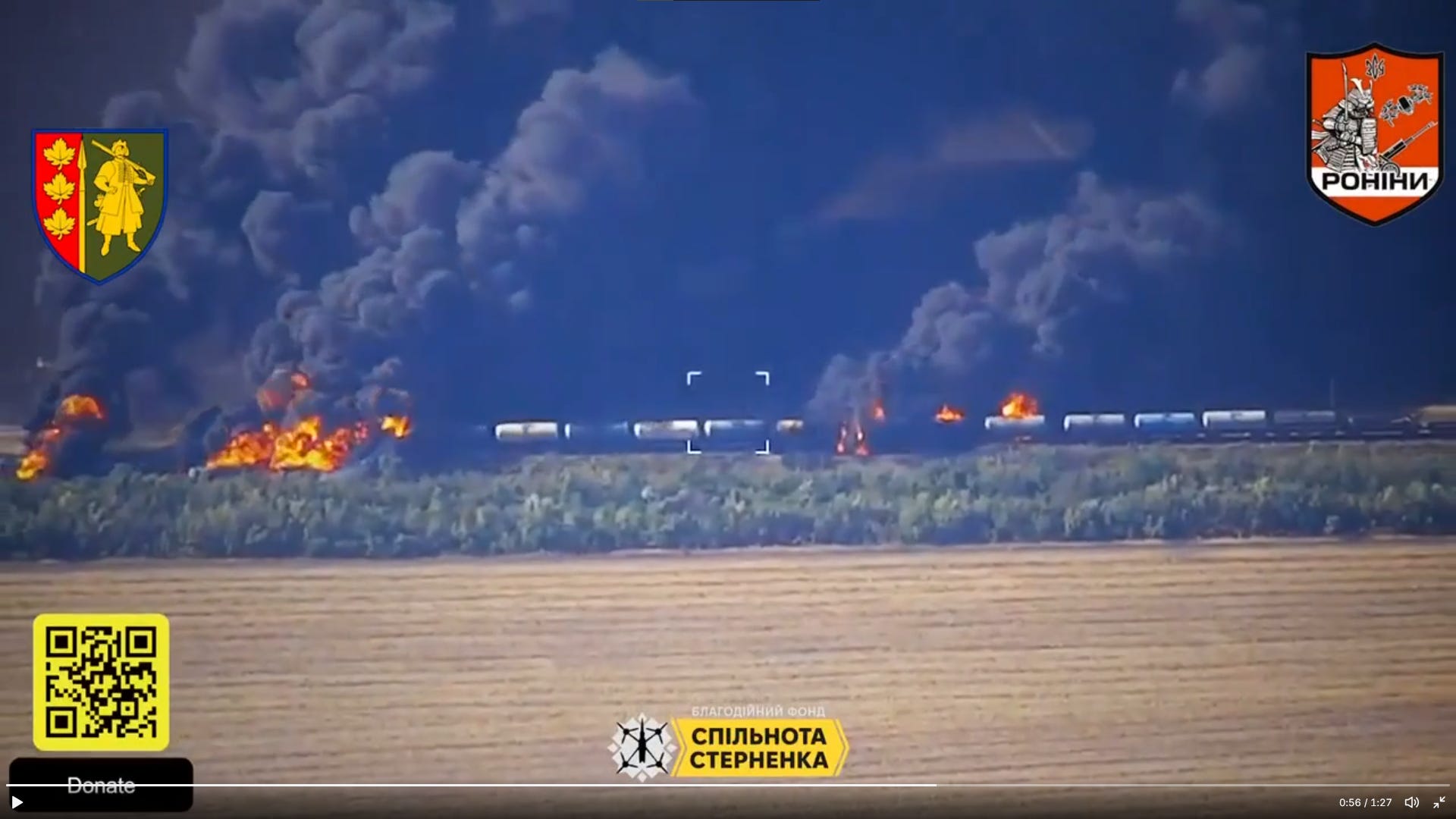
Further, the way Ukrainian reinforcements went in and professionally put the hurt on the orcs trying to advance near Dobropillya on the Pokrovsk front - well, I’m even more certain that the Ukrainians have some powerful reserves that have been sheltering behind the expanding drone wall for several months. The tactical proficiency of the Ukrainian troops clearing the area is apparent, ground drones already leading assaults and large numbers of enemy troops killed and a few captured with very limited Ukrainian losses.
Tactical skill is an essential part of the foundation for effective operations, which in turn are what accomplish strategic goals. Everything flows together in an energy management scheme. The question that will decide any major Ukrainian counteroffensive is whether Ukraine’s working doctrine can power comprehensive, systematic offensive operations at scale.
There’s plenty of work to be done on every front, and Ukraine may test the orcs in multiple places before deciding where to make any sustained move. With Putin acting like letting Ukraine have the small chunks of Kharkiv and Sumy seized is somehow a concession, liberating them and pressing over the border may be a Ukrainian political priority.
Smart money at the moment is on a counteroffensive in the Pokrovsk-Kostyantynivka area to secure both through winter. The epic assault on Volnovakha that I’d love to see may not be feasible, but I do find it interesting that once I started writing about the possibility this year the orcs - after a very long period where the area was largely ignored by orc command - started probing the exact area where I’d suggested Ukraine would build up troops. The incursion into Kharkiv around Milove and a series of small orc pushes along the Oskil near the international border are also suspiciously close to sectors I’d flagged for a potential Ukrainian push into eastern Belgorod.
Aside from some poor FSB peon assigned to monitor various blogs on the off chance they have a Ukrainian source or two who lets something useful slip, I don’t really believe anyone in Moscow actually pays attention to Rogue Systems Recon. The orcs are simply acting a lot warier these days than Moscow’s propaganda and the ongoing death toll suggests they need to. Front line formations are rotated off the line as soon as they lose more than about 20% of their personnel as casualties - usually their complement of disposable assault troops. The orcs are very, very afraid of being caught out again by a surprise Ukrainian counteroffensive. Their paranoia is as revealing as the slow but steady increase in the number of Ukrainian assaults conducted across the fronts.
Are Ukrainian actions all building up to something bigger? Or are the Ukrainians themselves bluffing that they aren’t hanging on by a thread? The past suggests the former: but there’s always first time for everything. And the real answer may well be somewhere in the middle.
Until a major effort is confirmed, I’ll keep trying to spot the signs. If Ukrainian intelligence monitors these posts, maybe they can use them to help gauge how effective their deception operations are. Think of my forecasts as serving as a kind of null hypothesis, the standard that any competent professional should be able to match or exceed. It’s been a long time since I was a soldier, and I trained for a very different kind of war. That experience plus a lifetime of reading professional military stuff has counted for a lot during the past few years of monitoring the Ukraine War, but I have no illusions about what working professionals not working solely to build a brand know and can accomplish. With some luck, maybe these posts help those training to support and one day replace them.
As far as the actual fighting on the fronts this week, it has certainly felt like Moscow’s advance on most fronts has struck a wall and is now recoiling in the face of aggressive Ukrainian counterattacks. But it’s too soon to be sure: it can take the orcs a week or two to reinforce a sector after suffering a bloody nose before taking a tree line here and there again. Ukrainians always have to be ready for the attacks to come again.
Another reason why they’re bound to throw their own punch whenever they can. Seizing the initiative is the only way to get a real breather where it counts the most. That’s one of the most important reasons to seek control over the pace of any fight.
Northern Theater
Sumy
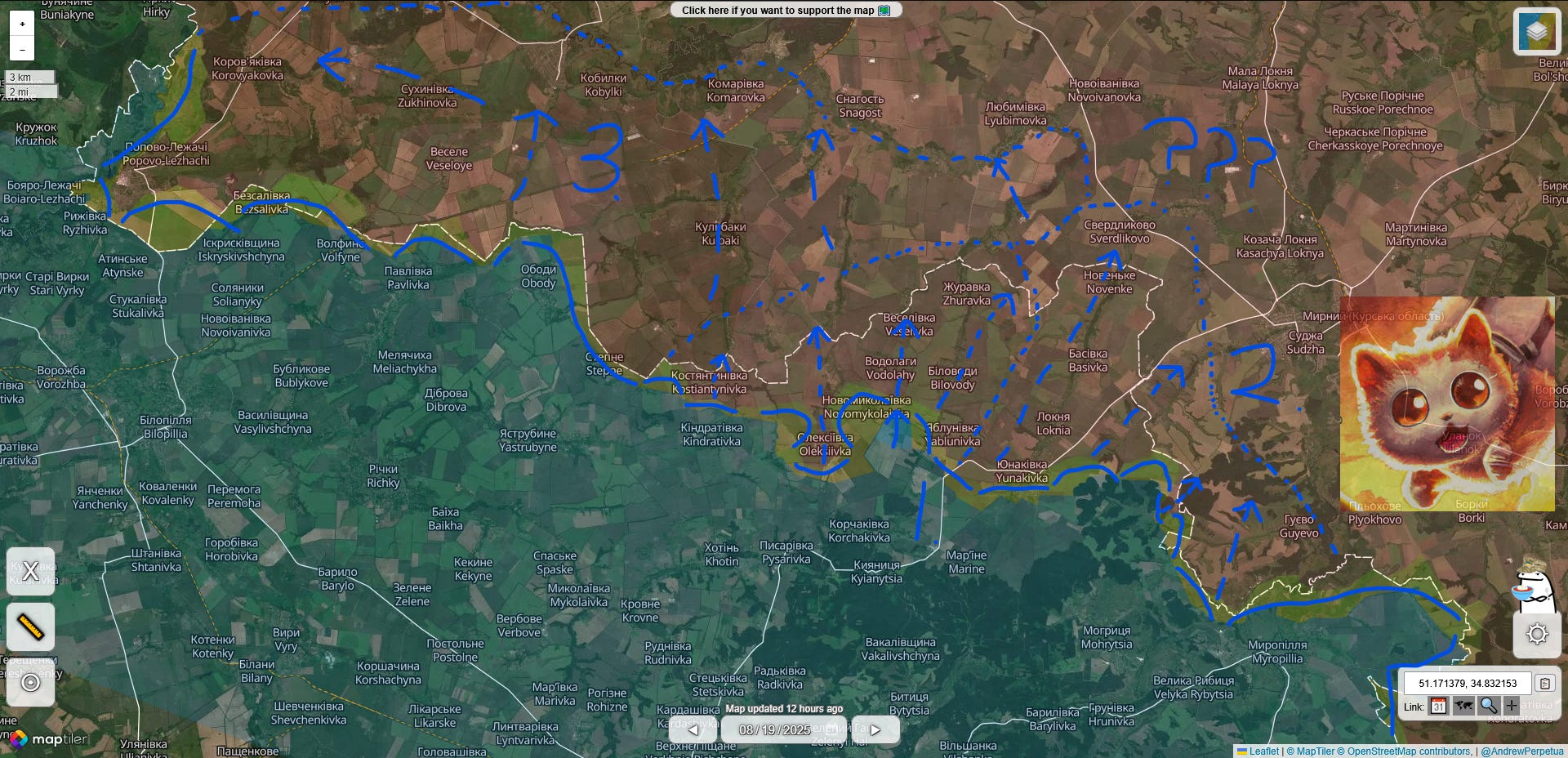
Open source maps aren’t showing a lot of confirmed territory reclaimed yet, but reports continue to suggest that Ukrainian forces are actively pushing the orcs back across the border across most of the incursion area. Moscow continues to attempt some advances, but mostly struggles to hold the line. The quality of forces that Moscow deploys here is declining as battered formations are pulled for recovery and reserves start to move to other fronts, suggesting that the Sumy offensive has failed and Moscow knows it.
Ukrainian fighters continue to pressure Tetkino, and may yet take advantage of disorganized and battered orc formations losing cohesion to seize Glushkovo district. The danger I see with this is the likely employment of North Korean personnel - they don’t appear to fight in Ukraine; defending Putin’s home turf appears to be their mission. Probably also acting as a hedge against a military rebellion by his own troops, who still disproportionately hail from regions Moscow would prefer to see mostly die off anyway because they cost more to keep alive than they produce.
Funny thing about the Muscovites is that they behave like first-year students in a graduate program in public policy who first discover cost-benefit analysis and go a little mad. They forget that using one analytical tool doesn’t automatically lead to effective policy.
Anyway, holding more than a few slivers of tactically useful Muscovite territory only makes sense now if peace talks really are expected to result in Ukraine giving up claims to its own territory. In that case, maximizing the amount of valuable enemy territory you hold makes sense. But this scenario is the one that leads to a bitter peace followed by Zelensky losing elections to Zaluzhnyi after the latter wins the military vote, so I doubt it’s the actual plan. No matter how much D.C. types want it to happen - Zelensky’s team isn’t stupid.
Kharkiv
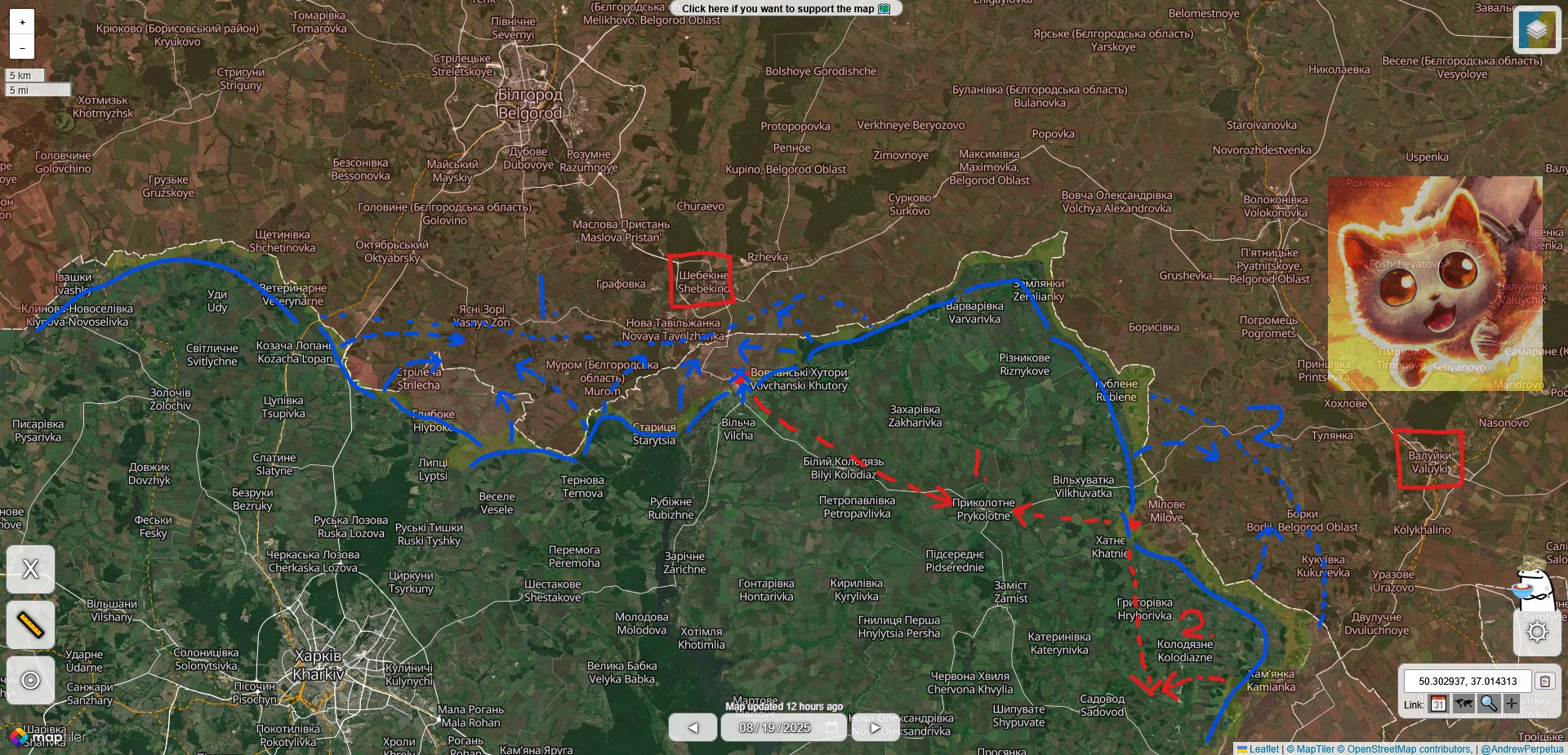
Moscow is still trying to make it look like a major push through the Vovchansk ruins towards the Kupiansk front is in the works, but hasn’t had any luck making efforts to advance here stick. Most of Moscow’s diversionary efforts aim to keep Ukrainian troops tied down, but wind up having a stronger impact on their own operations.
This is tied to the reason why interior lines are so powerful. Moscow has to spend twice the effort that Ukraine does to move large formations between fronts. The orcs want to prevent Ukraine from having any quiet sectors where weary formations can be rested, but fail to appreciate that a single weak brigade backed by elements of several strong ones in a reserve posture can hold a broad area against anything but a determined offensive.
In short, Moscow expends a tremendous amount of energy in ancillary areas for little net gain. Where the orcs have success, they overwhelm the Ukrainian defense over a long period of time. Putin thinks he’s playing Stalin on the Eastern Front in 1944, but Germany didn’t enjoy the advantage of interior lines that Ukraine does.
A breakthrough in Kharkiv would do serious damage to Ukraine’s defense. It’s just not looking likely considering what Moscow has been able to accomplish over the past fifteen months.
Eastern Theater
Kupiansk
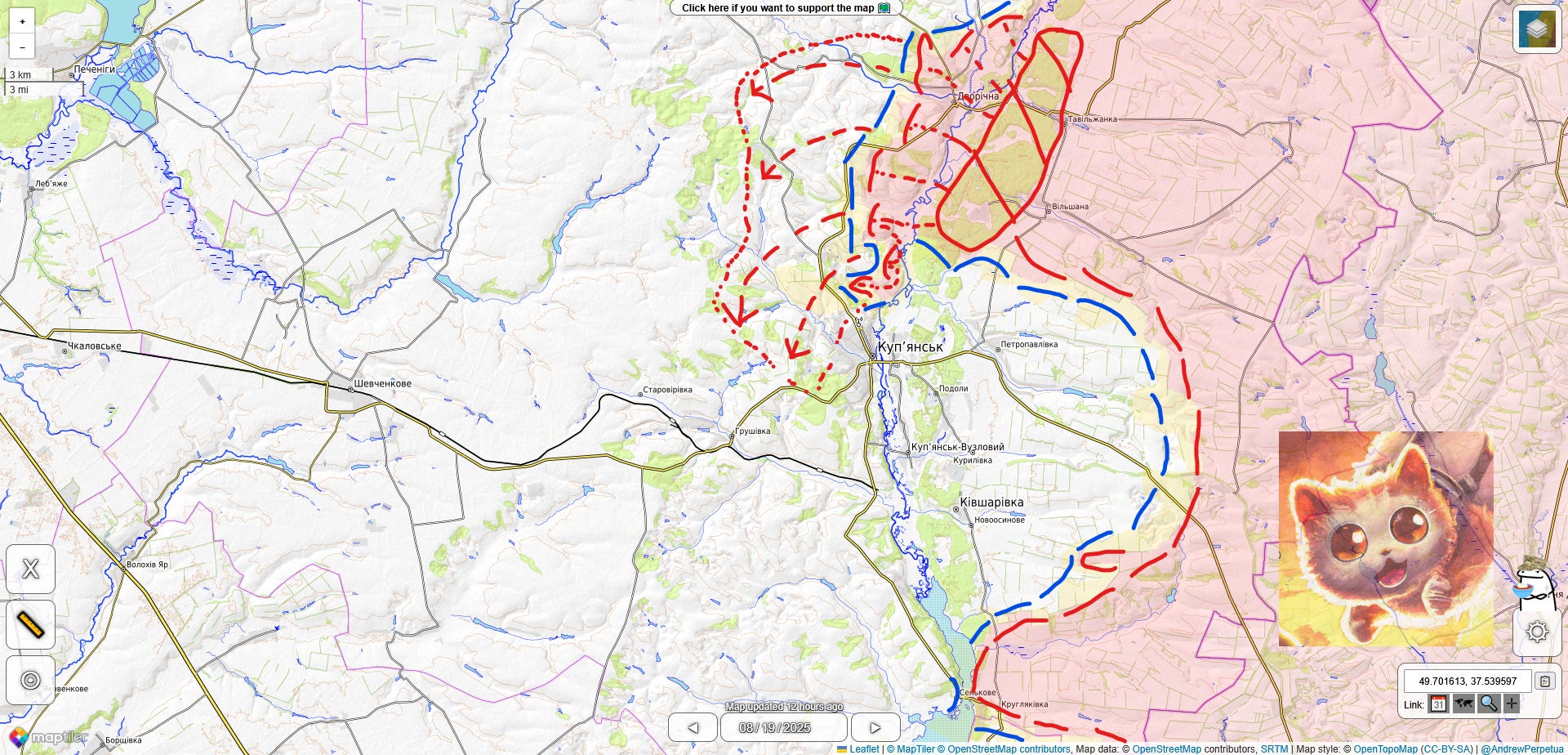
The orc threat to Kupiansk remains, but no progress has been evident the past week. For either side. Moscow’s bridgehead over the Oskil is powered by the proximity of a large forest tract on the opposite bank, which helps Muscovite officers sneak troops in to front line positions on the higher ground to the west.
The enemy can’t move vehicles across in force, but infantry teams constantly run the gauntlet to replenish frontline positions. Infiltration attempts are frequent, but even when successful don’t move the front quickly enough to break it. These remain the biggest danger to Kupiansk, either through getting into the town or cutting off the main supply trunks to the southwest.
Neither is likely, but attempts will be made. Unfortunately, a counterattack to clear the bridgehead appears unlikely because of how easily the orcs can support the line from the forests on the eastern bank. Clearing areas of the enemy is a time and resource suck. It also forces troops to spend time out of cover, making casualties more probable.
A balance must be struck between holding a dense enough front to repel infiltrators without clustering so much that a massive attack by orc fire support doesn’t inflict huge casualties. It’s never an easy one. So far the Ukrainian corps here is handling it.
Borova-Lyman-Siversk
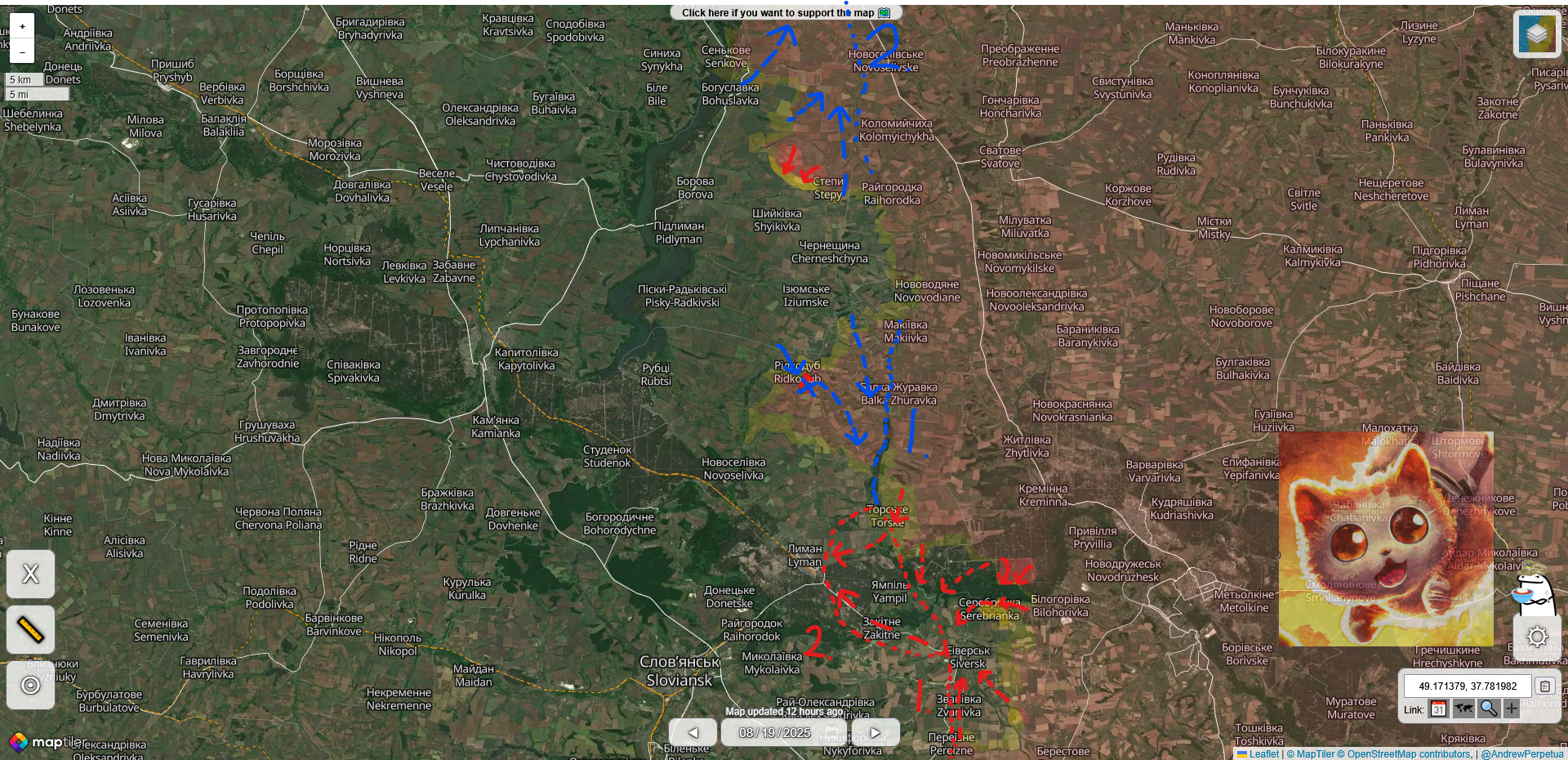
Third Army Corps lost a tiny bit of ground on the Borova front - several fields and the village of Zelenyi Hai. The Ukrainians here seem to have launched at least a spoiling attack on one flank to neuter the attack, and the advance has not yet been repeated or extended. Elements of Third Corps are still fighting hard for the town of Ridkodub, on the southern edge of the Borova arc.
This area is one where I would not be the slightest bit surprised to see a sudden local Ukrainian counteroffensive kick the orcs back to the Zherebets between Makiivka and Terny. Success would straighten the front substantially and allow Third Corps to more easily move reinforcements between the Borova and Terny fronts. The threat of an orc breakthrough in Siversk crossing the Siverskyi Donets would be strongly mitigated.
A simplified defense along the Zherebets ought to also make the Kupiansk front safer by enabling the reversal of the ruscist wedge that reached the banks of the Oskil to the north of the Borova area. If the southern approaches to Kupiansk are clear, creeping enemy progress from the north is bound to stall out.
Can Third Army Corps do it? Is it worth the cost? I suppose that depends on how badly the orcs are suffering in the process of keeping the bridgehead intact.
Just to the south, Lyman and Siversk are slowly merging into one large front, the two towns serving as gateways to the upper reaches of the Siverskyi Donets river and the rear of the Sloviansk urban agglomeration. Ukrainian positions in the forested area along the northern bank west of Yampil have long hindered enemy efforts to advance on either side. That seems doomed to change.
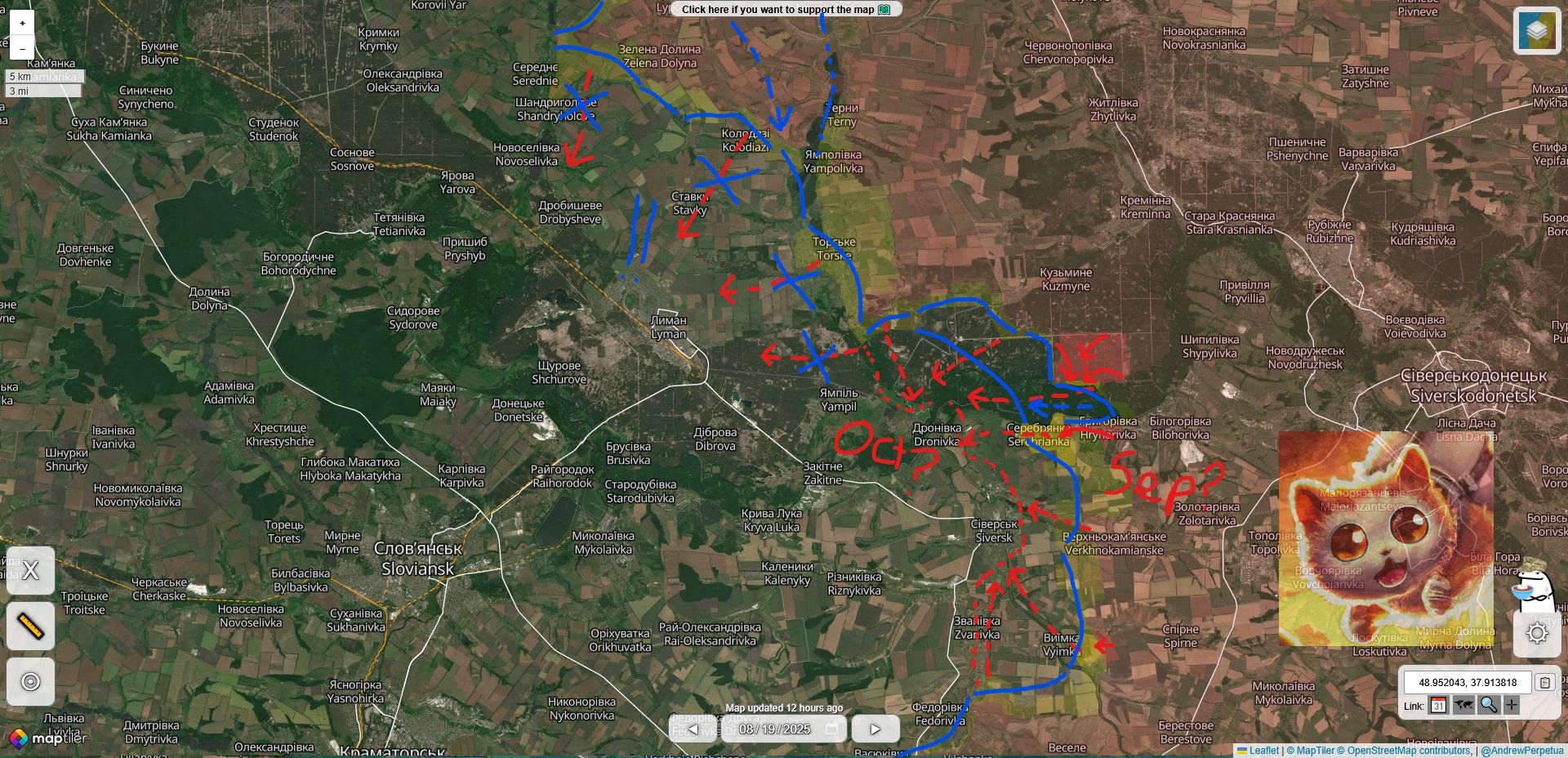
The enemy is going through the work of pushing Third Army Corps forces back from the eastern stretches of the riparian area bit by bit. Combat in this area is distinct from that taking place across much of the rest of Ukraine because the close forest prevents perpetual drone surveillance. Close-quarters infantry work is common, and tactical movements are fraught because of bogs and waterways that won’t be fully described by satellite recon.
Moscow is hoping to shove the Ukrainians out all the way up to the Zherebets river, but progress will almost certainly depend on how hard the Ukrainians fight for the opposite bank of the Siverskyi Donets, closer to Siversk. The enemy may have reached the town of Srebrianka, and if true the Ukrainians in the forests will likely need to pull about halfway to the Zherebets. Town sits in a bowl, though, so I pity the orcs trying to hold it - smart move for the Ukrainians to defend elsewhere.
Its loss would however seem to portend the Ukrainians being forced back to defend Siversk proper in the next month or so. The town is reportedly in ruins, so might not be fit to hold for very long. A Ukrainian line along the Bakhmutovka would match up well with one etched into the west bank of the Zherebets. The fall of Siversk would mean that Ukraine would have to be ready to fight hard for the Yampil-Dronivka area. Hence it being ideal if the Borova front was straightened out…
Kostyantynivka
Only a tiny bit of movement to report on the Kostyantynivka front this week: some slight orc progress north of Chasiv Yar as well as in Toretsk. Ukrainian fighters are still holding out strong for the most part in both sectors, able to fairly quickly rotate fresh troops into the fight from the urban area with the front being ten kilometers away in both directions.
An unfortunate consequence of Chasiv Yar and Toretsk slowly being demolished over the past two years has been that Kostyantynivka is less shielded against air, artillery, and drone attacks. The proliferation of fiber-optic drones with a range of up to twenty kilometers means that drones pose a constant threat to soldiers and civilians alike, and higher-flying surveillance drones can call down artillery strikes in minutes. It cannot be overstated how much the battlefield is now defined by rushing across a ten kilometer hunting ground to rapidly assault a target position and get under cover before drones come rolling in - or worse. Grad rockets might not be accurate, but I’ve not heard of anybody who actually enjoys being shelled by the things.
Moscow’s inability to break Ukraine’s front hinges on never being able to target and neutralize enough Ukrainian positions fast enough to prevent its own forces from being chewed up before they can bring strong pressure to bear. The pace of any Ukrainian counteroffensive must be extremely rapid during movement phases. Drones have to be at the bleeding edge to ensure that the enemy is never able to freely concentrate and coordinate efforts, too busy putting out fires.
Not much apparent potential for a Ukrainian counterattack on the Kostyantynivka front, I’m afraid. Here the task is making the orc grind as slow and painful as possible without taking too many casualties in return. Urban Donbas is a fortress the orcs are in the process of breaking their teeth on. Its job is to absorb combat power, enabling a vicious counterstrike somewhere else.
Pokrovsk
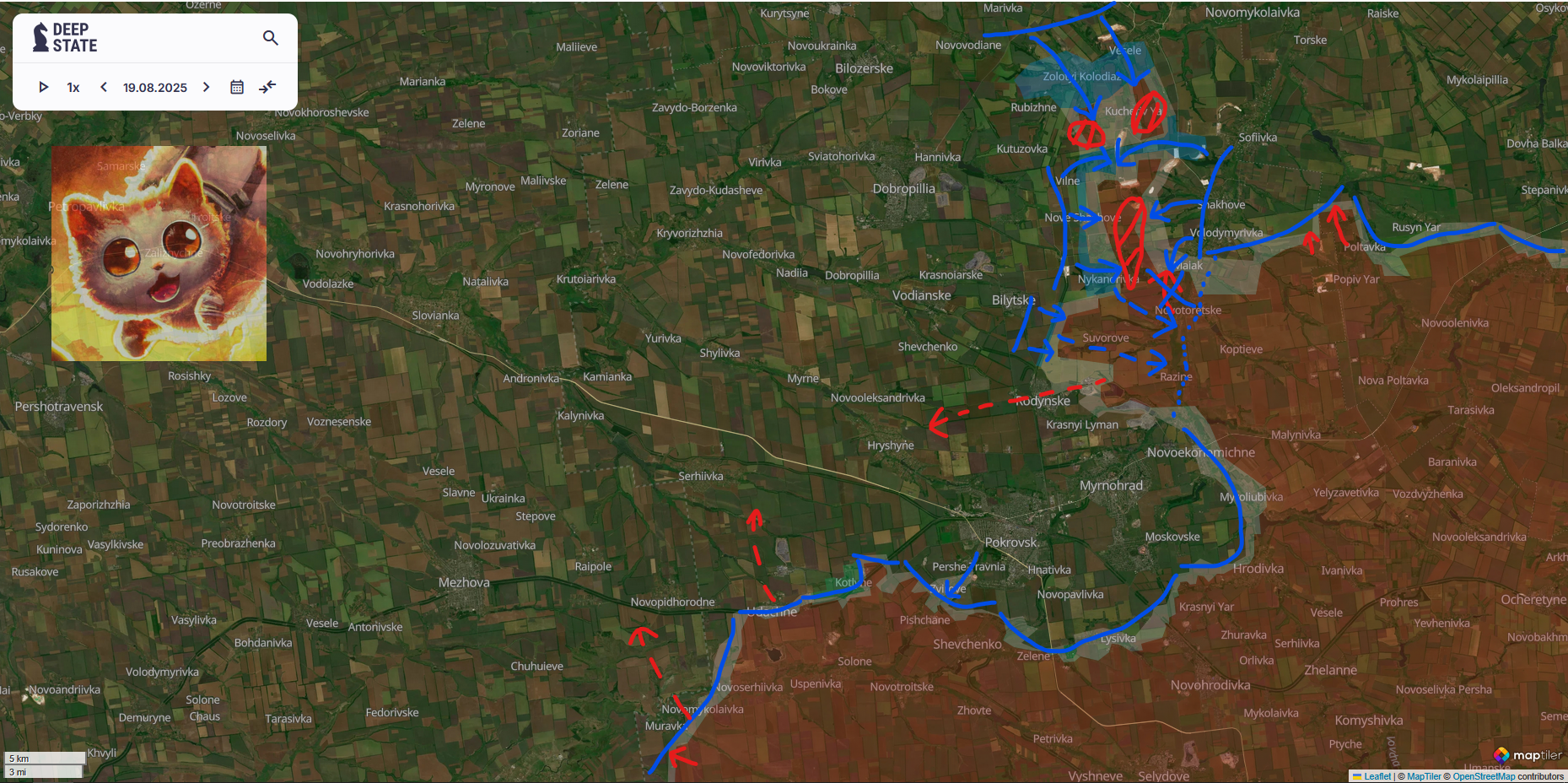
Having just written that, it probably comes off as pretty hypocritical that I’ve been so adamant about the need for an immediate local counterattack on the Pokrovsk front. But needs must: the primary objective in any effort from an energy management standpoint is to inflict maximum damage for the effort invested while trying to accomplish something that will have broader repercussions. Defeating the enemy’s main attack always counts - it’s just usually advisable to strike somewhere else and make the opponent shift their forces to keep them off balance.
And right now the Ukrainians appear to be doing a bang-up job of allowing rested veteran brigades to demonstrate refined tactics against an over-extended orc assault force. Over the past week, exactly as I’d hoped to see, the Ukrainians cut off the infiltration teams that sought to push north of Dobropillya and methodically annihilated most of them - the rest are surrounded and doomed. Heavy mechanized reinforcements were intercepted and halted along the Kazenyi Torets river near Mayak, where Ukraine appears to be working to restore its defense lines.
Not only have the original several hundred infiltrators that streamed through an apparent gap in corps coverage areas been almost wiped out, but twice as many coming to exploit their apparent success were too. You stick your neck out too far, it gets cut…
All pretty classic in terms of an active defense scheme. The front lines are not a continuous wall of soldiers in trenches: positions are separated by hundreds of meters. It is only possible for any one position to hold off so many attackers in a given span of time. Penetration of forward positions up to five or ten kilometers is normal - provided that infantry teams are available to go in and clear out any infestation.
Elsewhere in Pokrovsk orc assaults continue, but have so far been reliably repelled. Intensive attempts to close a second jaw around the town from the southwest are underway, and failing.
Good thing, because Ukraine’s margin for error on this front is at zero. Lack of flexibility is very dangerous in this kind of fight. Hence the need for a broader counteroffensive in the Pokrovsk area before winter. If Moscow pulls out all the stops, clearing Pokrovsk block by block might be seen as worth the cost. Ukraine would find it very difficult to hold any positions within about twenty kilometers. It’s entirely possible that if Ukraine loses Pokrovsk, all of fortress Donbas is doomed to fall as the enemy cuts it off from the west.
The battle for Pokrovsk is far from over; more than a hundred thousand orcs are assigned to the sector and probably ten thousand more are being dispatched from other fronts, particularly Sumy. Moscow seems to finally be learning that it’s important to concentrate power and double down on success. But if a full fresh corps full of rested crack troops just entered the fight, the pain for orc command north of Pokrovsk could just be getting started. A much broader unraveling is possible if the orc logistics lines supporting the Pokrovsk offensive are badly damaged by drone and missile attacks.
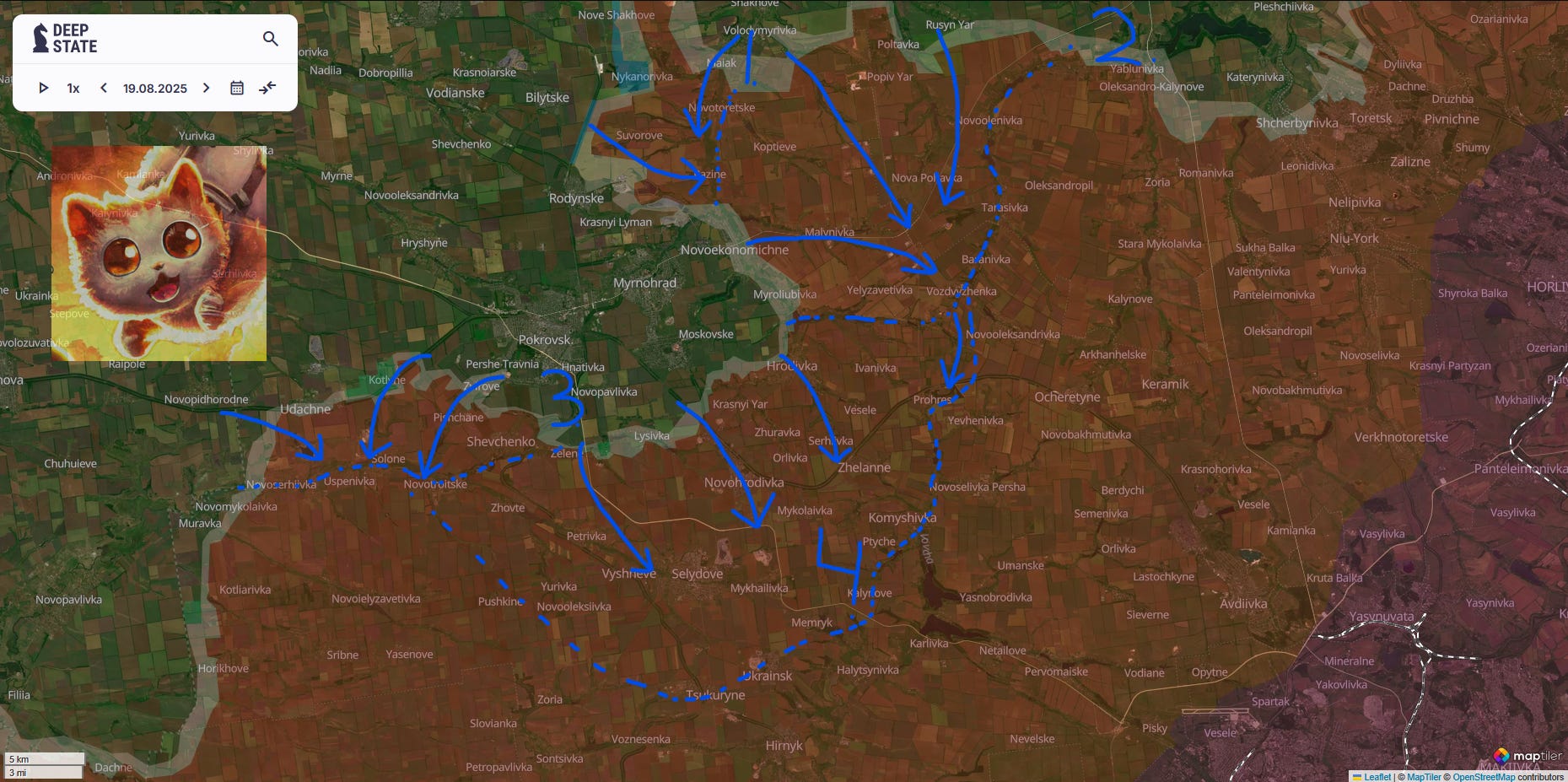
As I’ve laid out in the past, throwing the enemy back to the Bychock line by Vozdvyzhenka would be excellent - the Vovcha near Ukrainsk and Hirnyk even better. It would mark the total defeat of Putin’s summer push to finally seize Pokrovsk - and also spell doom for the long assault on Kostyantynivka. A final phase of a push like this could potentially see Ukrainian fighters bashing in the enemy front around Pokrovsk to reclaim Selydove - the town where those infiltrators reportedly staged before hiking thirty kilometers to the front then another fifteen into Ukrainian territory.
There, exhausted, most of them died. Sure, argue that this is Putin winning the war, go ahead! Any volunteers for the next infiltration assault through Ukrainian lines? Didn’t think so.
Vovcha
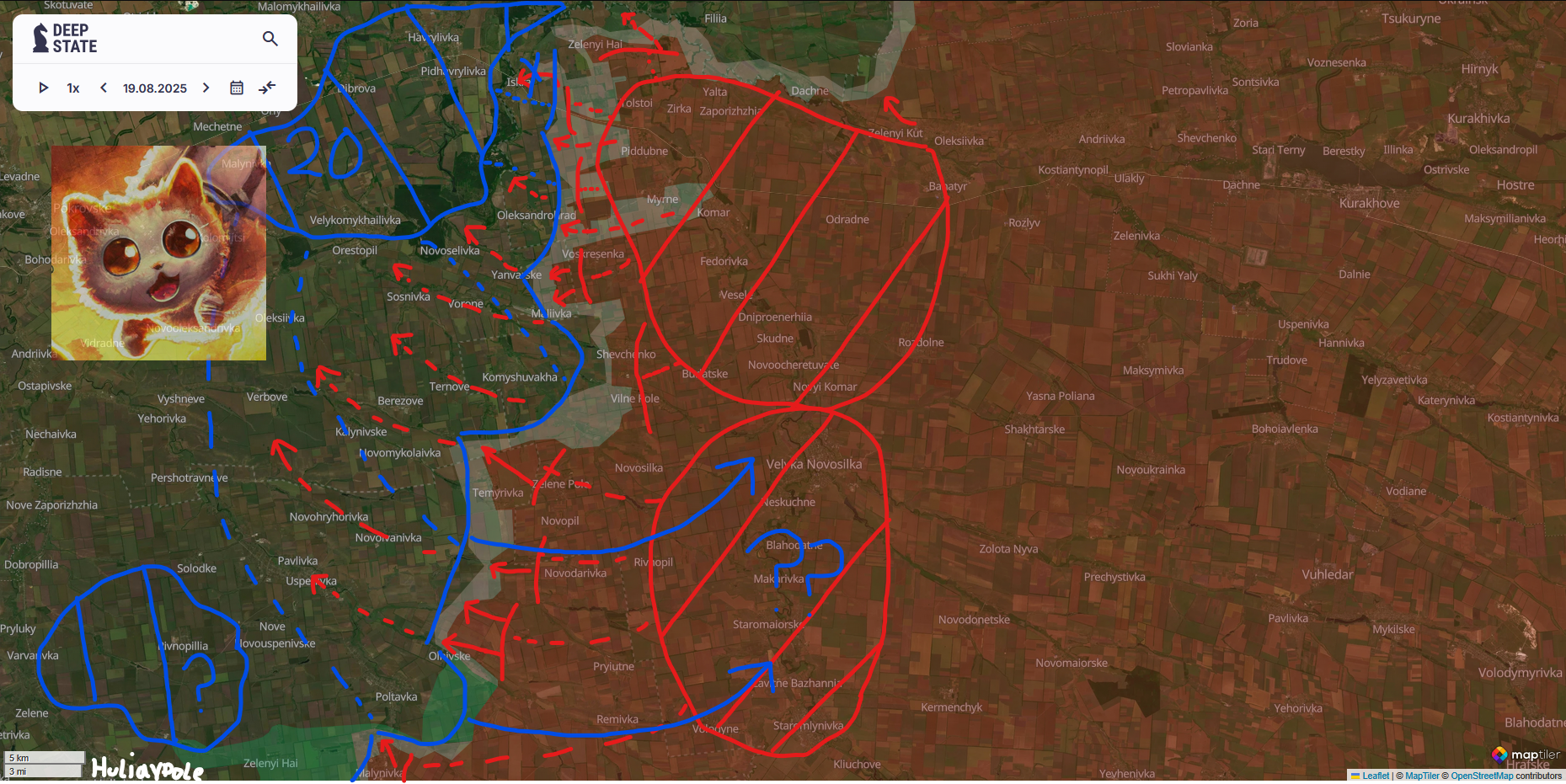
I’ve decided to rename the Novopavlivka front, because the actual perimeter around Novopavlivka all the way from the Solona down to the Vovcha at Dachne and Filia remains intact. Veteran 72nd Mechanized Brigade seems to be heading up a corps here, and since the current perimeter formed it’s hardly budged in weeks. The primary purpose of Ukrainian forces deployed here is to cover the southern flank of Pokrovsk. Could be that they’d participate in a march on Selydove instead of holding in place as I indicate on the map above.
South, beyond the confluence of the Vovcha and the Solona along the forest belts at the Dnipro district border, the orc advance is taking on a different character as the enemy’s advance towards Novopavlivka stalls. The push at the northern end of the Vovcha front is being halted as and where anticipated. The enemy reached Andriivka-Klevtsove (formerly known as Iskra, I guess?) and staged another propaganda flag raise. This was immediately followed by Ukrainian troops demonstrating their continued control over the area, implying the death or capture of the orcs involved.
Probably as a direct result of running into obstacles at the northern end of this front, Muscovite efforts to advance on the southern wing have intensified. This always seems to happen: once stopped on the main line of advance Moscow shifts to the next one over.
Ukraine’s 20th Army Corps looks to be bringing the Muscovite march west from Velyka Novosilka to a halt. Along the Dnipro district border Ukrainian fighters working from prepared fortifications are smashing up orc attempts to breach the line. Moscow’s command here is having to activate portions of the front closer to Huliaypole in an obvious bid to get around 20th Corps’ right flank.
If the plan really has been to lure the orcs to this point before punching out from Huliaypole, it’s sure shaping up exactly as I’d have hoped. If the Ukrainians can paralyze and overpower the orc combined arms army covering the space between Orikhiv and Huliaypole and turn the flank of the one pressing the flank of 20th Corps, very good things could happen.
I can’t claim that this is likely, but the opportunity sure looks to have formed up when and where I’d have hoped, were I in Syrskyi's shoes earlier this year. If it truly is possible to roll back the majority of the enemy’s gains in Donbas since early 2024, sometime in the next six weeks the effort will have to begin. Once the leaves fall from the trees and the ground turns to mud, rapid, large-scale movement properly covered by drones will get a lot harder - at the very least, more infrequent.
Though if Ukraine’s drone game gets good enough, it might be possible to simply fight on as the weather allows. Ukraine might even have an advantage in winter fighting now. The way technology is racing along, it’s hard to say.
Southern Theater
Orikhiv
Talk of a large Muscovite offensive in Zaporizhzhia has morphed into warnings about imminent plans, but so far whatever the orcs have been up to lately hasn’t worked out well for them. An advance group that reached Stepnohirsk was destroyed about a week ago, and it’s a safe bet that the space between it and Kamianske is a drone-infested dead zone.
Still, Moscow has always maintained a substantial grouping of forces around Tokmak and Melitopol as a hedge against any Ukrainian surprises and a constant threat to march north towards Zaporizhzhia. This necessitates securing Orikhiv using the same methods required to approach any other Ukrainian defensive node: created two jaws and work them closed.
So far there isn’t any evidence that the orcs have enough forces to accomplish this. Ukraine’s announcement of impending enemy offensive operations in Zaporizhzhia could be a cover for moving forces into position for a Ukrainian counteroffensive. Wouldn’t be the first time that’s happened in this war.
Kherson
There also continues to be talk of the enemy establishing a bridgehead across the Dnipro in Kherson. This would make political sense, though not military: the cost is bound to be atrocious, but Putin is busy bluffing that Ukraine had better make a deal before it loses more than just Donetsk, Luhansk, Crimea, and the portions of Kherson and Zaporizhzhia across the Dnipro. So some poor bastards might have to die to raise some flags on the Ukrainian-held shore.
Gotta love how Team Trump made sure to put up a big and completely misleading map of Ukraine showing what percentage of certain districts is occupied during those farcical talks this week (never mind that the bulk of the population in both Kherson and Zaporizhzhia are still free). The propaganda purpose is impossible to miss. Same as co-opting the language of peace to push surrender.
It’s annoying to watch the Europeans play along, but if you’re wise to the game, Trump is the one who comes off looking like the weak fool he keeps proving himself to be. But hey, he’s just a representative of the culture that spawned him. I keep suggesting to people that at least Manhattan gets incinerated for the good of the planet, but nobody’s up for it. Yet.
Air, Sea, Strike
No major news on the aviation front, except for an orc Su-30 jet going down near Ukraine’s coast south of Odesa. Strange that Moscow would risk a fighter there - and that Ukraine didn’t claim the kill if one was scored. That becomes more likely if an F-16 was involved and the Ukrainians worry that Moscow is playing a game to suss out Viper operating patterns - or the Viper in question used a weapon Ukraine would prefer the orcs not know about.
The development of Ukraine’s air force hasn’t attracted a lot of news lately, so I have to expect that every few months another half a dozen Vipers and Mirage 2000s along with trained pilots are added to the roster. Maybe true long-range air-to-air missiles have arrived too? Or (even less likely) even a few Meteor-armed Gripens? So far in this war whenever the Europeans and Ukrainians have clammed up about something for a long while it portends the emergence of new capabilities.
Excellent case in point: the announcement that a new cruise missile in the same class as the American Tomahawk - bigger and with better range, in fact, though likely less accurate - has already been used in combat. With initial production capacity reported to be 50 missiles per month, that gives Ukraine a powerful new deep strike tool going forward.
Cruise missiles are vulnerable to a properly networked air defense system with lots of sensors plugged together, but Moscow’s has proven unable to stop Ukrainian drones and miniature cruise missiles, so adding in some bigger models should lead to serious damage on targets previously impossible to cripple or destroy.
The Ukrainians now stand to unleash complex drone and missile raids on targets anywhere in Muscovite Europe every few nights. Several large cruise missiles accompanied by several dozen small ones can fly in the wake of a couple hundred long-range strike drones that suppress and distract enemy air defenses. Multiple parts of a target complex can be hit at once, the biggest warheads getting at reinforced or buried structures.
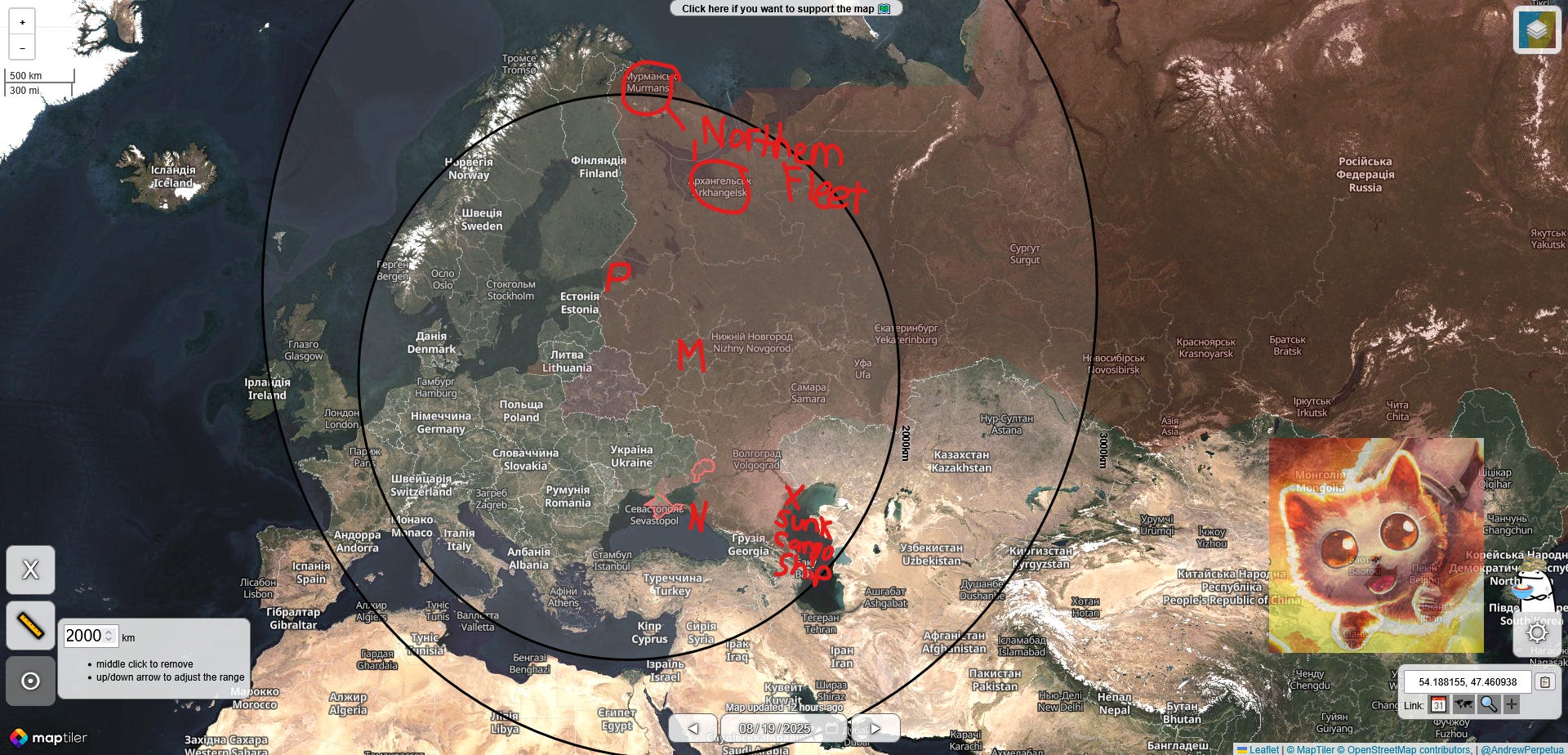
A couple years ago, when small numbers of ATACMS ballistic and Storm Shadow/SCALP-EG cruise missiles were being held up by some as the western wonder-weapons that could win Ukraine the war, I argued that while they would be nice to have, even better would be investing in producing Ukrainian equivalents at scale. A couple different ballistic missiles have been developed by Ukrainian engineers, Hrim and Sapsan, and one of these Iskander equivalents or both seems certain to be deployed soon.
It’s going to be awesome in a year or two when Ukraine is fielding a Patriot-equivalent air defense system as well. No more need to play American games then!
Moscow’s strategic strike campaign has been muted of late, no doubt to curry favor with Trump while stocking up for an intensive series of big strikes down the line. The several hundred Iskander ballistic missiles Moscow has reportedly managed to hoard represent the enemy’s primary operational-level heavy artillery. Anything expensive that clusters, or even an infantry platoon that’s especially unlucky, can draw a shot. Sadly, it’s always going to be difficult to provide total coverage against ballistic threats. Dispersal, camouflage, regular moves, and early warning are key.
It’s intriguing how the cost equation shifts depending on the type of attack that has to be stopped. Using multiple interceptor drones to down strike drones is nearly always affordable because they’re simpler and smaller than the targets they hunt. Short-range missiles are okay too, radar-guided flak as well. Medium-range surface-to-air missiles cost about as much as a small cruise missile, so using them to defend against this type of target makes sense, but not drones, if it can be avoided. Ballistic missiles reach extremely high speeds, making any form of intercept very difficult: the interceptor has to be even more sophisticated than the inbound projectile. Not a fun cost curve if you’re on the defending side.
Investing in large numbers of smaller ballistic missiles may make a lot of sense. Israel’s use of ballistic missiles on combat jets looks very sensible given the results in Iran, and the technology should be possible for Ukraine to replicate in fairly short order. Ability to fire the missiles from low altitude and still strike several hundred kilometers from the launch point would let Ukrainian jets conduct operational strikes from a safe distance behind the front. The venerable Su-27 fleet may be a good candidate for carrying them, given their big engines and carrying capacity. Su-24s seem to have an inexhaustible supply of spare parts, though.
Drones are great for saturating enemy defenses and going after surface targets, but the payload on a missile is still indispensable. Cruise missiles are cheaper than ballistics but more susceptible to interception, so should work best when sent at the heart of a swarm of smaller weapons. Ideally, these can be equipped with radar detectors to help them go after air defense systems and pave the way for bigger missiles. Between that and decoys, saturation of most defenses ought to be doable. Putting airfields out of commission may be possible by taking out underground fuel reservoirs.
Drones that can home in on radar emissions stand to become a serious problem for air defenses very soon. It should not be technically very difficult to conduct mass suppression of enemy air defenses using drones edging over into robot territory. A drone told to fly to a general area then home in on anything emitting in certain wavelength bands doesn’t need operator support - maybe not even GPS. Anything that emit signal can be detected and targeted. Electronic warfare systems are also highly vulnerable to being tracked this way. Even small explosions can cripple delicate gear.
Another very interesting technical question right now is the relative efficiency of drone and automated solutions to different problems. Robots tend to be best when the landscape and objectives are simple: go there, attack a target matching certain unique characteristics. Drones work best when any level of discretion is required. Pairing drones and robots is highly attractive: a drone can fly itself to an area and wait for an operator to log in and identify valid targets. This need not be strictly synchronous: if signal throughput is weak but the target options and parameters sufficiently fixed, control can be executed in stages. That’s often how probes in deep space and on other planets must be controlled.
Rarely is any technology, whether AI, drones, or anything else, a truly revolutionary game-changer all on it’s own. What typically drives paradigm shifts in military affairs is the creative hybridization of different technologies. The future, in short, belongs to the cyborgs: mutually beneficial combinations of the best aspects of flesh and machine. Truth be told, cyborgs owned the past, too: what is any craft but the integration of human intelligence and the capabilities of a simple machine?
At sea, the only noteworthy development this past week was Ukrainian intelligence using drones to destroy a cargo ship moving Iranian supplies across the Caspian Sea. Formerly inaccessible to Ukrainian strikes, any ability to target infrastructure in this region is quite valuable.
Iranian support is now less relevant than North Korean, but it still exists. That means Moscow has to defend the Caspian Sea area, because Tehran sure can’t.
Staff Affairs
Additional clues about how Ukraine’s great military reboot is culminating in the new corps taking responsibility for their assigned sectors continue to emerge. As expected, the Ukrainians are starting to group most or all of their tanks together in a single brigade assigned to each corps. Termed heavy mechanized brigades, they’ve been slowly forming up for a while, with all of Ukraine’s five former tank and about as many of the better-performing Territorial Guard brigades so flagged.
Each fields two tank and four infantry battalions, half in armored vehicles, the other armored trucks, where most line brigades now host six infantry battalions, half mechanized, half motorized. Unlike the five or six line brigades the comprise the bulk of each corps, the heavy mech brigades are probably broken into companies and attached to beef up battalions in line brigades as required. It’s a reasonable way to employ tanks, which while still extremely valuable and versatile have to be used with great care.
Assault regiments appear to be forming up in each corps as well, containing two or three battalions focused on close-quarters infantry fights. They seem designed to form the spearheads of corps-level counteroffensive operations in conjunction with the heavy mech brigades. Each corps should be able to rapidly and substantially reinforce a line brigade’s area of responsibility, giving it a dedicated trained assault force to help breach the enemy front. Line teams will secure positions bypassed by the advance guard, letting drone teams quickly deploy.
Corps are getting other essential supporting elements too - artillery, drone, and supply brigades, along with formations that handle logistics, repair, administration, and all the other organs needed to give the organism maximum autonomy. The nuances of the landscape in each corps area mean that a substantial portion of recruit training needs to take place within the corps, not at a national training center. It does appear that each corps is building up a training pipeline, which is a sign of reforms going as they should.
The corps have reportedly all been stood up: evidence of their effectiveness should be apparent soon. It is to be hoped that improved coordination at all levels can further drive down Ukrainian casualty rates and open the door to a general counteroffensive.
Concluding Comments
I am well aware that the general consensus among the media and expert class is that Ukraine’s position is bleak. I’m not arguing otherwise because I’m some old school contrarian blogger convinced that nobody but people I like can do anything right and devoted to Zelensky. The reason I have trust in the Zelensky-Syrskyi team is that their actions have almost always managed to follow one of the few trajectories out of this nightmare of a war that doesn’t lead straight to a descent into something worse.
From the beginning, I didn’t think Donbas was worth Ukraine shedding blood for. Handing it over now would be a terrible gut punch, but if Ukraine got back everything else that was lost and truly credible security guarantees, then I’d say the bitter deal is worth taking. If the actual deal is Donbas and Crimea for the end of any Muscovite claim to have any interest in the rest of Ukraine for all time, and that’s externally enforceable - okay. The territory doesn’t matter in the short run so long as Ukraine is secure.
But what security guarantees can ever be credible if they hinge on D.C. - or worse, Moscow? It us pure insanity to believe that either will live up to any agreement they make under present circumstances. For both, negotiations are just another way to carry on the underlying conflict, just shunting the battle into a domain that politicians like themselves are more comfortable with, because they know the odds of everything blowing up in their face is lower.
The Minsk agreements put in place after Putin first invaded Crimea and Donbas never worked because Putin isn’t lying about exactly one thing: the roots of the conflict remain unresolved. Moscow claims sovereignty over Ukraine on cultural, linguistic, and historic grounds and can never budge on certain issues - obviously Ukraine can’t either, any more than the USA can grant Moscow special rights over Russian-speakers in the USA. The evidence suggests this to be a ploy to take more later on.
Either enough of the world collectively stands up to physically reject Putin’s argument that he can redraw borders at his will with necessary force, or everyone stands to see this madness tried out in their back yard for generations to come. That represents a global catastrophe on par with a nuclear exchange - and will cause one eventually.
There are threats facing everyone on this planet that, if not addressed in a hurry, will intersect to create a very nasty future. Covid-19 was an introductory-level global pandemic that most countries failed to cope with. Energy shortages are already beginning to throttle global economic growth. The planetary biosphere is dangerously polluted, and the weather is getting very strange.
Desperate people left behind in the churn will buy into mad schemes that worsen the chaos. Enough of the rest had better hang together, or we’ll assuredly all hang separately. And if enough of the world can’t figure out how to stop Putin, forget about all the other problems. They’re even harder. Rarely do you get an enemy as obviously virulent as Putin to fight. Motivating people to mobilize against anything more abstract than a genocidal tyrant bent on playing the love child of Stalin and Hitler is a pipe dream.
When it comes to effective security guarantees for Ukraine, no matter the shape of any hypothetical peace deal the fact remains that sufficient combat power must be perpetually available and prepared to repel a renewed Muscovite assault. Talk of a NATO-lite bound by an equivalent to Article Five sounds fantastic, but the devil is in the details. It is almost certain that Putin will violently test any pledge of support to Ukraine under the assumption that it might fall apart when physically challenged.
If you’re offering security guarantees to Ukraine, you’re basically saying that you’re ready to go to war with Moscow. But if that isn’t true today and hasn’t been at any point before now, how can anyone honestly believe that it would be any time soon?
Everything about the war in Ukraine always reduces down to the same basic challenge: assembling enough combat power to repel Moscow’s advances and reclaim anything the Muscovites stole. Only that prevents Moscow from pushing further, not words.
Believe me, I desperately want to stop feeling any obligation to write about this conflict or military affairs in general. I’ve tracked this war long enough to more than confirm theories I’ve been working on for twenty years. War truly is boring, and it never really changes.
My empathy in this fight is most strongly felt for the ordinary soldier stuck trying to survive this hell. If there was any hard evidence that fewer would die in the long run if Ukraine accepted a bitter peace now whatever the cost, I’d advocate it as the lesser of all evils. Countries are not worth dying for - but sometimes they’re the only organizing institution capable of keeping anyone alive. One of those sick paradoxes of life.
Science is what it is, and the history of wars suggests that ones of this kind rarely just grind to a halt. Someone loses their grip on the situation and slips; the front begins to move, and in what seems like the blink of an eye everything changes. In the case of Armenia and Azerbaijan, the transition took a generation, but it happened.
Sorry, Team Trump, but you had nothing to do with ending that war. Azerbaijan won the thing years back: the recent peace treaty only represented Armenia’s decision to accept the end of the fighting for good.
The breakup of the Soviet Union was merely placed on a merciful pause for a quarter of a century. But history is back, and it’s in a foul mood.




